 Image search results - "maru" Image search results - "maru" |
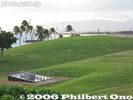
Ehime Maru Memorial in Kakaako Waterfront Park, Honolulu えひめ丸慰霊之碑The memorial is on a slope with a good view of the ocean. It was indeed a suitable place for such a memorial.
|
|

Maruoka Castle is Japan's oldest surviving castle tower although it collapsed during the Fukui Earthquake in 1948. Rebuilt in 1955 with most of the original materials. Originally built in 1576 by Shibata Katsutoyo, nicknamed Kasumiga-jo (Misty CastlePhoto: Way to Maruoka Castle from the bus stop.
|
|

Ryogoku Kokugikan sumo arena as seen from Ryogoku Station
|
|

Entrance to Honmaru Goten palace, Kawagoe Castle.
|
|
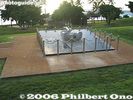
The memorial was unveiled on Feb. 9, 2002, a year after the accident.
|
|

Entrance to castle grounds
|
|

Crowd outside the Kokugikan await their favorite wrestlers.
|
|
|
|
|

The stone marker says National Treasure Kasumiga-jo Castle.The castle was a National Treasure until it collapsed in the 1948 Fukui Earthquake. Now an Important Cultural Property.
|
|

Crowd enters the Kokugikan for Musashimaru's retirement ceremony on Oct. 2, 2004.
|
|

Garden
|
|
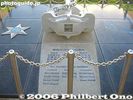
On Feb. 9, 2001, a small Japanese fisheries training boat from Uwajima, Ehime Prefecture was struck by the USS Greeneville submarine as it bolted to the surface off the coast of Honolulu, Hawaii. Nine Japanese high school students, teachers, and crewmen died aboard the Ehime Maru. A year later, a waterfront memorial was built in Honolulu.
|
|

Maruoka Castle tower
|
|

Passing out programs
|
|
|

Names of the nine Japanese who died
|
|

Maruoka Castle tower
|
|

Musashimaru at the entrance
|
|
|

Inscription in English
|
|

Maruoka Castle tower
|
|

Musashimaru greets the crowd
|
|
|

Inscription in Japanese
|
|
|

Hawaii's last sumo wrestler shakes hands.If he were married, his wife would be beside him.
|
|

Veranda facing a garden.
|
|
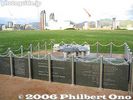
I hope the former submarine commander Scott Waddle comes here on each anniversary of the accident and pray for their souls.
|
|

Path to castle tower
|
|

Musashimaru right after I shook his hand.
|
|
|

Maruoka Castle
|
|

Signboard for retirement ceremony at entrance.It reads "Musashimaru, Intai Danpatsu Hiroo Ozumo" which means "Musashimaru Topknot-Cutting and Retirement Sumo Exhibition."
|
|

Hill where the Fujimi Turret once stood.
|
|
|

Musashigawa stablemaster (former Yokozuna Mienoumi) in the entrance hallInside the entrance hallway, there was a long table on the left side with ribbons which served as name tags for distinguished guests. Musashigawa is the name of Musashimaru's sumo stable.
|
|

Former castle moat.
|
|
|

Entrance hall is clogged up by a side show of hula.
|
|

Old shachi (killer whale) roof ornaments made of stone.The original shachi were made of wood with copper plating. But during WWII, the precious copper was taken and these two stone shachi were made to replace the original shachi. These two shachi fell off the roof during the 1948 earthquake and were replaced by a replica of the original made of wood and copper plating.
|
|

Musashigawa Stable wrestlers greet visitorsIncludes Miyabiyama and Musoyama.
|
|

Steps to castle tower entrance.
|
|

In the entrance hall, hula and Hawaiian music direct from Hawaii
|
|

Side of castle
|
|

The retirement ceremony had a lot of Hawaiian touches. This was only the beginning.Hula dancers and live Hawaiian band from Hawaii.
|
|
|

Konishiki also sings. (His company arranged the entertainment.)
|
|
|
|

Musashigawa Stable wrestler wearing Aloha-print yukataFlowery pattern (plumeria) with "Musashimaru" imprinted.
|
|
|

Musashimaru souvenirs at the Kokugikan's souvenir shop
|
|
|
|

Musashimaru merchandise
|
|
|

Musashimaru doll
|
|

Entrance to castle tower
|
|
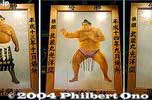
Giant painted pictures of Musashimaru decorating the arena inside. Each one commemorates a tournament victory.These giant pictures are actually black-and-white photographs taken in a photo studio and printed on large paper. Then it is hand-painted in color by a woman who has been doing it for years.
|
|

1st floor of castle towerThe steep stairs go to the 2nd floor.
|
|

The ceremony opens with taiko drum beating on the sumo ring.
|
|

1st floor of castle tower
|
|

Sumo exhibition matches with lower division Makushita wrestlers.A retirement ceremony for an important sumo wrestler includes a variety of activities besides the actual ceremony of cutting away the topknot. It involves almost the entire Japan Sumo Association, and most wrestlers in the top three divisions (Makushita, Juryo, and Makunouchi) also appear in exhibition matches.
|
|

1st floor of castle tower with photos of other castles.
|
|

Makushita sumo matchLower-division wrestlers wear black belts, while the upper division wrestlers wear white belts (during practice) or colored belts during official matches.
|
|

Old-style "bay window?"
|
|

Juryo Division dohyo-iri ring-entering ceremony
|
|

"Sama" hole to shoot weapons (arrows or guns)
|
|

Juryo sumo match
|
|

2nd floor
|
|

Hairdressing demonstration
|
|

Roof tiles made of stone (rare)
|
|

Sumo match with kidsA retirement ceremony for an important sumo wrestler includes a variety of activities besides the actual ceremony of cutting away the topknot. It involves almost the entire Japan Sumo Association, and most wrestlers in the top three divisions (Makushita, Juryo, and Makunouchi) also appear in exhibition matches.
|
|

Roof tiles made of stone (2nd floor)
|
|

A retirement ceremony for an important sumo wrestler includes a variety of activities besides the actual ceremony of cutting away the topknot. It involves almost the entire Japan Sumo Association, and most wrestlers in the top three divisions (Makushita, Juryo, and Makunouchi) also appear in exhibition matches.
|
|

Roof tiles made of stone on Maruoka Castle
|
|
|

Stairs to top floor
|
|

The kids gradually get bigger.
|
|

Stairway on top floor
|
|

Ozeki Musoyama is defeated.
|
|

Memorial marking Itoh Chobe'e's house, right near Itoh Chube'e's house. Chobe'e was Chube'e's older brother and co-founder of Marubeni Corporation.
|
|

Top floor
|
|

Yobidashi wearing Aloha-print garb
|
|

Top floor
|
|
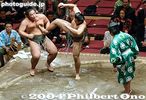
Comic sumo (shokkiri sumo)This is comedy time with two young wrestlers performing various comical antics (spitting at each other, kicking, and other illegal sumo acts) on the ring.
|
|
|

Comic sumo (shokkiri sumo)This is comedy time with two young wrestlers performing various comical antics (spitting at each other, kicking, and other illegal sumo acts) on the ring.
|
|

Veranda (closed to visitors)
|
|

Tidying up the ring
|
|

View from castle tower
|
|

Musashimaru finally appears for a yokozuna belt demo
|
|

The veranda is narrow and the fence is low.
|
|

Musashimaru acknowledges a spectator as he proceeds to the ring.This was a demonstration on how they tie on the thick, white rope (tsuna) around his waist. The tsuna is the symbol of the yokozuna. It takes several assistants to put it on. They are all wearing white gloves.
|
|
|

Yokozuna "tsuna" belt demo
|
|
|

They wrap the rope around his waist from the front, or the thickest part of the rope.This was a demonstration on how they tie on the thick, white rope (tsuna) around his waist. The tsuna is the symbol of the yokozuna. It takes several assistants to put it on. They are all wearing white gloves.
|
|

Ceiling on top floor
|
|

Pulling it tight
|
|

Ceiling on top floor
|
|
|
|

Ceiling on top floor
|
|

Tying the rope at the back.
|
|

Ceiling on top floor
|
|

Rear view of the shiranui style of tying the rope.He turned in all four directions to show everyone what it looked like. This is what is called the shiranui style of tying the rope. It is characterized by a single loop in the back. The other style, called unryu, has twin loops.
|
|
|

Musashimaru goes back and then comes back...
|
|

Stairs going down
|
|
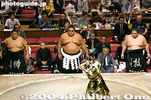
He performs his last yokozuna dohyo-iri ring-entering ceremony. He is flanked by Musoyama on the left as the sword bearer, and Miyabiyama on the right as the dew sweeper.
|
|
|

Musashimaru's final dohyo-iriHe could have had Yokozuna Asashoryu be either the sword bearer or dew sweeper, but he chose to have his stablemates to join his final dohyo-iri.
|
|

Well related to the castle's mist.
|
|

Musashimaru's final dohyo-iri
|
|

Lower stone wall
|
|

Musashimaru's final dohyo-iri
|
|
|

Musashimaru's final dohyo-iri
|
|
|

Musashimaru's final dohyo-iri ends
|
|
|

He goes back to the dressing room
|
|

Folk History Museum adjacent to the castle. 歴史民俗資料館
|
|
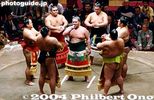
Sumo jinkuThey are singing sumo jinku, a chant-like song about sumo and sumo wrestlers. They are singing about Musashimaru and his career.
|
|

Folk History Museum
|
|

Laying the red carpet for the main event.
|
|

Inside Folk History Museum
|
|

This must be a first, a kumu hula (hula teacher) from Hawaii performing on the sumo ring.He is Sonny Ching, a well-known hula teacher in Hawaii. He brought four male hula dancers who danced at the four corners of the ring.
|
|

Edo Period currency
|
|

Kumu hula Sonny Ching beats the ipu gourd drum, a traditional Hawaiian instrument. This must be a first, a kumu hula performing on the sumo ring in Japan.
|
|
|

Male hula dancer at one cornerThe original plan was for the hula dancers to perform on the ring itself. But at the last minute, Musashimaru decided that it was not appropriate so they danced outside the ring.
|
|

Kasumiga-jo Park, noted for cherry blossoms.
|
|

Calling Musashimaru (with a conch shell)
|
|

Bus stop for Maruoka CastleTakes about 40-50 min. from Fukui Station.
|
|

Here he comes...
|
|

Head supporter speaks
|
|

The chair
|
|
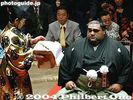
The scissors (golden)I think it was given by French President Chirac who is a sumo fan.
|
|
|

Snip by actor Hiroshi Fujioka, who played Kamen Rider in the '70s.
|
|

Oh, I gotta take a picture of this...Look at the gyoji referee who must be thinking, "C'mon, hurry up!"
|
|

Snip by singer Shigeru MatsuzakiFamous for his classic hit, "Ai no Memory."
|
|

Konishiki is called and he enters
|
|

Snip and a hug by Konishiki (Question: Where was Akebono??)
|
|

Snip by Musashimaru's brother
|
|
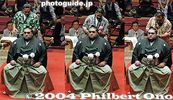
More blood relatives (or brothers)
|
|

Snip by Kitanoumi, the head of the Japan Sumo Association
|
|

Snip by Yokozuna Asashoryu and a symbolic passing of the baton from one foreign yokozuna to the next (and only) foreign yokozuna.Mongolia's Golden Age of Sumo has begun.
|
|

Snip by stablemate Ozeki Musoyama
|
|

He was grim-faced all throughout
|
|
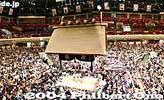
Panoramic shot of the KokugikanNotice the upper floor was quite empty, similar to Akebono's retirement ceremony.
|
|

Awaiting the final cut as we listen to one of his famous matches.
|
|

The final cut by stablemaster Musashigawa Oyakata.
|
|

Musashimaru minus his topknot
|
|

The End of Hawaii's Golden Age in sumo. For the first time since 1968, no wrestler from Hawaii is in the top Makunouchi division.
|
|

Nephews give a flower bouquet (they can step on the sumo ring)
|
|

His mom is next...
|
|

But his mom cannot step on the sumo ring...Females are prohibited from entering the sumo ring. Barring women from stepping onto the sumo ring, even to give an award to a wrestler, is one of the most blatant and preposterous forms of sexual discrimination in Japan. It was devised centuries ago, and for the sake of tradition, traditionalists in the sumo world have maintained this extremely absurd custom and belief that women are considered to be impure (due to menstruation). I'm not saying this as a gaijin (foreigner) who likes to criticize Japan or the Japanese. Nor am I saying this as a women's rights advocate. I say this from the standpoint of plain, old common sense.
Up to 1909, women were actually not allowed enter a sumo arena to view sumo matches. And once upon a time, women were prohibited from setting foot on sacred Mt. Fuji. Can you imagine if these traditions were still being practiced today?
Such discriminatory practices were abolished long ago, and here we are in the 21st century with women still unable to step into the sumo ring. The Japan Sumo Association has constantly rejected requests from important female ministers in the Prime Minister's Cabinet to give an award to the tournament winner in the sumo ring.
|
|

Musashimaru and his flowersThis was his last appearance at this retirement ceremony.
|
|

Makunouchi dohyo-iriNext was exhibition sumo matches by the top-division Makunouchi wrestlers. Musashimaru never appeared again.
|
|

Makunouchi dohyo-iri
|
|

Makunouchi dohyo-iri
|
|

Makunouchi dohyo-iri
|
|

Makunochi dohyo-iri ring-entering ceremony
|
|

Yokozuna Asashoryu performs his dohyo-iri ring-entering ceremony
|
|

Taiko drum demonstration
|
|

"Robocop" Takamisakari gets readyThe top-division Makunouchi wrestlers went through their matches quickly.
|
|

Takamisakari wins
|
|
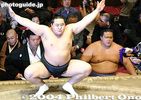
Final match of the day with Yokozuna Asashoryu
|
|

Asashoryu in the face-off
|
|

Asashoryu later won
|
|

Yumitori-shiki bow-twirling ceremony
|
|

Exiting the building
|
|
|

Cruise ship at Naze Port pointed at Tachigami Lighthouse island. The small island is like the port's good luck charm.
|
|
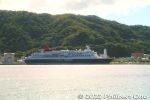
Cruise ship at Naze Port, Amami-Oshima.
|
|

Cruise ship at Naze Port, Amami-Oshima.
|
|
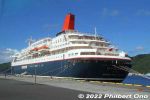
Nippon Maru cruise ship at Naze Port, Amami-Oshima.
|
|

Way to Cape Ayamaru lookout point.
|
|
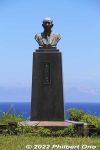
Bust of Nagano Yoshitatsu (1898–1984 永野芳辰) at Cape Ayamaru. Nagano was a Japanese government bureaucrat who helped to revert Amami islands back to Japan in 1953. He was born and raised on Amami Oshima. Later became governor of Kochi Prefecture.
|
|

Photo spot at Cape Ayamaru.
|
|
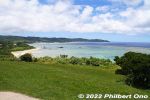
Cape Ayamaru scenery.
|
|
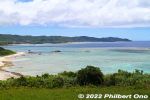
Northern coast of Amami Oshima as seen from Cape Ayamaru.
|
|
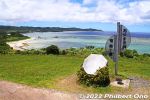
Cape Ayamaru sign and photo spot, Amami Oshima, Kagoshima.
|
|

Cape Ayamaru sign and photo spot.
|
|
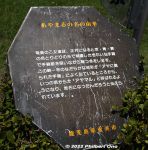
How Cape Ayamaru got its name.
|
|
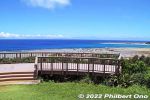
Lookout deck at Cape Ayamaru with views of the coral reef and ocean. Amami Oshima, Kagoshima.
|
|

Lookout deck at Cape Ayamaru shows a beautiful aqua-blue ocean.
|
|
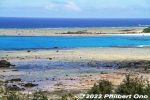
Lookout deck at Cape Ayamaru shows a beautiful aqua-blue ocean.
|
|
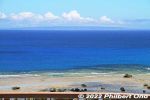
Lookout deck at Cape Ayamaru shows a beautiful blue ocean beyond the coral reef.
|
|
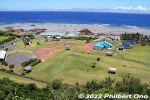
Recreational park down below from the lookout point on Cape Ayamaru.
|
|
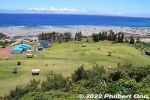
Recreational park down below from the lookout point on Cape Ayamaru.
|
|
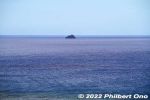
Tonbara Rock as seen from Cape Ayamaru. トンパラ岩
|
|

Local buses stop here too, not often though.
|
|
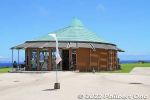
Gift shop.
|
|

Tokyo Millenario was a brilliant sculpture of light mounted over a street in Marunouchi near Tokyo Station. From 1999 to 2005, it was held during the last week of the year until New Year's Day. The event was discontinued after 2005 due to constructioTokyo Millenario was mounted over a small street in Marunouchi called Marunouchi Naka-dori during the last week of the year. It lit up from 5:30 pm to 9 pm and on Jan. 1 (the last day), from midnight to 3 am. It became a major winter attraction, with over 2 million visitors in 2004.
The crowds were horrendous. It took 40 min. or longer just to get in. Photo: 5:05 pm: At the back of the line.
|
|

5:16 pm: Our line merges with another one coming from Tokyo Station
|
|

Behind us
|
|

"Red light ahead, please stop..."
|
|

5:34 pm: Entrance in sight
|
|

Title of work: "Corolle Liberty" by Valerio FestiThe artist is Italian.
|
|

Entrance. The entrance gate is 22 meters tall and 19 meters wide.
|
|
|
|

5:40 pm: Entered Tokyo Millenario street
|
|
|
|

Back of entrance
|
|
|
|

"No stopping please..."
|
|

Less crowded at the end. After you pass through the main street, there are more decorations on the side street. You can also backtrack on the main street along the sidewalk only.So if you want to see the Millenario really quickly and don't mind not being in the middle of the street, go on the sidewalk.
|
|
|
|
|

"Quadrifogli " (Clovers of Light) at Tokyo Station
|
|

Tokyo Station
|
|

East Gardens of the Imperial Palace 皇居東御苑
|
|

Suwa-no-Chaya Teahouse 諏訪の茶屋
|
|

Suwa-no-Chaya Teahouse 諏訪の茶屋
|
|
|

Prefectural trees from all prefectures 都道府県の木
|
|

Miyazaki Prefecture's official tree 都道府県の木(宮崎県の木)
|
|

Ninomaru Garden 二の丸庭園
|
|

皇居東御苑
|
|
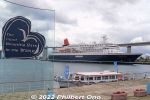
Cruise ships usually dock here at Toyama Shinko Port (富山新港). In Oct. 2014, Toyama Bay was admitted to the "Most Beautiful Bays In The World Club." This is one monument for it. https://world-bays.com/category/bays/asia/japan/
|
|
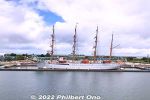
Toyama Shinko Port (also called Toyama New Port) has a major tourist attraction in the Kaiwo Maru (海王丸) museum ship brought here in July 1992.
|
|
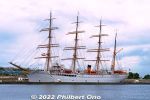
Kaiwo Maru was built in 1930 as an officer training ship for Japan's merchant marine. Its sister ship was the original Nippon Maru sailing ship also built in 1930 as a training ship. Kaiwo Maru was retired in 1989 and replaced by a new Kaio Mar
|
|
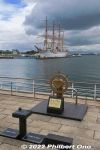
The Kaiwo Maru was launched on Feb. 14, 1930, Valentine's Day, so people have associated the ship with love. Yumi Katsura Lover's Sanctuary Monument and Kaiwo Maru in the background.
|
|
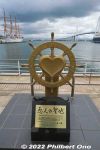
Yumi Katsura Lover's Sanctuary Monument built in 2006. Yumi Katsura is a wedding dress designer.
|
|
|
|
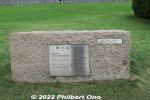
Monument for awards bestowed on Kaiwo Maru Park for waterfront park design and concept.
|
|
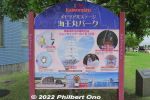
Kaiwo Maru Park sign of love especially for Valentine's Day.
|
|
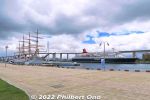
Kaiwo Maru and a Japanese cruise ship at Toyama Shinko Port.
|
|
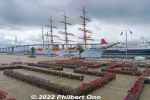
About 10 times a year, they unfurl Kaio Maru's sails. Lucky if you see it with all the sails out.
|
|
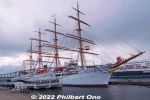
For a small admission fee, you can board and tour inside Kaiwo Maru. Well worth it.
|
|
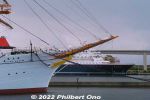
Bow of Kaiwo Maru.
|
|
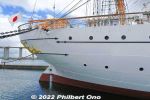
Stern of Kaiwo Maru.
|
|
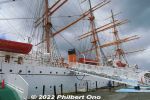
Gangway to board Kaiwo Maru.
|
|

About Kaiwo Maru. It's 97 meters long. "Kaiwo" (or Kaio) means "King of the Seas."
|
|

Brief history of Kaiwo Maru.
|
|
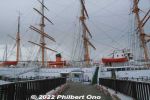
Boarding the Kaiwo Maru museum ship.
|
|

Visitors can tour the top deck (forecastle and poop decks), upper deck, and 2nd deck. Upper deck has the dining/lecture room, Captain's quarters, and officer's saloon. The 2nd deck has cadet cabins.
|
|
|
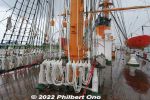
Walking on the top deck.
|
|
|
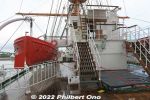
The stairs go to the bridge.
|
|
|
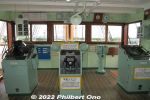
Inside the bridge of the Kaiwo Maru.
|
|
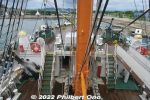
Forward view from the bridge of the Kaiwo Maru.
|
|
|
|
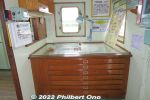
Inside the bridge.
|
|
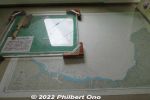
Map charts inside the bridge.
|
|
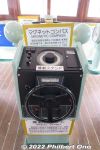
Magnetic compass on the bridge.
|
|
|
|